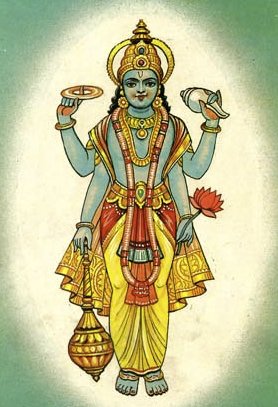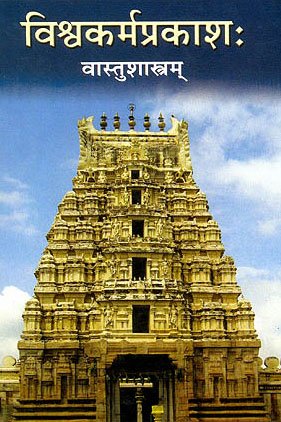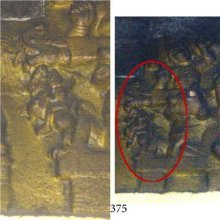Garbhagriha, Garbhagṛha, Garbha-griha: 24 definitions
Introduction:
Garbhagriha means something in Hinduism, Sanskrit, Jainism, Prakrit, the history of ancient India. If you want to know the exact meaning, history, etymology or English translation of this term then check out the descriptions on this page. Add your comment or reference to a book if you want to contribute to this summary article.
The Sanskrit term Garbhagṛha can be transliterated into English as Garbhagrha or Garbhagriha, using the IAST transliteration scheme (?).
Images (photo gallery)
In Hinduism
Vaishnavism (Vaishava dharma)
Source: ISKCON Press: GlossaryGarbhagṛha (गर्भगृह).—Inner sanctuary or altar room that contains the main Deity of the temple. The literal meaning is “womb chamber.”

Vaishnava (वैष्णव, vaiṣṇava) or vaishnavism (vaiṣṇavism) represents a tradition of Hinduism worshipping Vishnu as the supreme Lord. Similar to the Shaktism and Shaivism traditions, Vaishnavism also developed as an individual movement, famous for its exposition of the dashavatara (‘ten avatars of Vishnu’).
Vastushastra (architecture)
Source: Wisdom Library: Vāstu-śāstraGarbhagṛha (गर्भगृह) refers to the “sanctum” of a temple.
Source: Shodhganga: Temples of Salem region Up to 1336 ADGarbhagṛha (गर्भगृह, “sanctum”) is the nucleus of the temple. It is the place where the main deity of the temple is installed. The Canons prescribe that the shape of the garbhagṛha may be (on plan):
- caturaśra (square),
- āyata (rectangular),
- vṛtta (cicular),
- āyatavṛtta (elliptical)
- or vṛttāyata (ovoid).
The square and circular garbhagṛhas are constructed for the installation of the deities in sthāṇaka (standing) or āsīna (seated) postures. While in the other varieties, deities in śayana (reclining) posture or group of deities standing or sitting in a row are to be installed.
Mānasāra mentions that if the plan of the garbhagṛha is square or circular, it is called puruṣa (Male) and if it is rectangular it is called vanitā (Female). Male deities can be installed in a square, circular or rectangular garbhagṛha, while the female deity should always be installed in a rectangular garbhagṛha.
Source: Shodhganga: Ajanta’s antiquity (vastu)Garbhagṛha (गर्भगृह, “womb-house”).—When combined the two words [garbha (womb) and gṛha (accommodation)] become garbhagṛha (womb-house). It denotes the sanctum sanctorum, or shrine of a sacred space, especially that of a Hindu temples. The sanctum sanctorum is the most central and fundamental component of any sacred architecture. What garbha (womb) is to the human body gṛha (accommodation) and guhā (cave) are to the world of habitation. What gṛha is to the world of habitation garbhagṛha is to the sacred architecture. In garbha resides the foetus, the genesis of a being. In gṛha, resides the gṛhastha, the family man—the microcosm, a unit, of which the multiples make a society, and which is opposed to the macrocosmic sphere of civilization. In the microcosmic sphere of the garbhagṛha, the God resides, who is referred to as the macrocosm in religions, the omnipresent, all-pervading entity.
Source: Knowledge Traditions & Practices of India: Architecture (1): Early and Classical ArchitectureGarbhagṛha (गर्भगृह) refers to the “sanctum sanctorum”, a common concept found in the ancient Indian “science of architecture” (vāstuvidyā).—Garbhagṛha is the sanctum sanctorum, where the presiding deity is installed.
Source: Shodhganga: The significance of the mūla-beras (vastu)Garbhagṛha (गर्भगृह) or Mūlasthāna sanctum-sanctorum of the Hindu Temple.—Each temple has a mūlasthāna or garbhagṛha (sanctum-sanctorum) and many subsidiary sanctums. The temples here selected for the study of the mūla beras are temples specially dedicated to Śiva, Viṣṇu, Subrahmaṇya, and Pārvatī. In these garbhagṛhas, there are icons of gods and goddesses, namely, Śiva and His manifestations like Naṭarāja; Pārvatī and the Śakti avatāras; Viṣṇu and His other forms and incarnations; Brahmā, Lakṣmī, Sarasvatī, Subrahmaṇya, Valli, Deivāṇai (also known as Deviyāni or Devasena), and Gaṇapati.
Source: OpenEdition books: Architectural terms contained in Ajitāgama and RauravāgamaGarbhagṛha (गर्भगृह) refers to “(geha) cella §§ 3.12, 33, 37; 4.7.”.—(For paragraphs cf. Les enseignements architecturaux de l'Ajitāgama et du Rauravāgama by Bruno Dagens)
Source: Shodhganga: Elements of Art and Architecture in the Trtiyakhanda of the Visnudharmottarapurana (vastu)Garbhagṛha (गर्भगृह) refers to the “sanctuary” part of the Hindu Temple, according to the Viṣṇudharmottarapurāṇa, an ancient Sanskrit text which (being encyclopedic in nature) deals with a variety of cultural topics such as arts, architecture, music, grammar and astronomy.—Garbhagṛha means the central hall i.e., the sanctuary in the middle, where the statue of the deity is placed. The term itself refers to a place which is not seen from outside like a womb in a female body. The garbhagṛha is basically a small room inside the main temple which is mostly square in size, plane or rectangular as well as many-sided or circular in rare cases. Stella Kramrisch, the author of the book The Hindu Temple also keeps the view point regarding the garbhagṛha in the similar way. [...] The Viṣṇudharmottarapurāṇa recommends a separated room inside the main temple which can be considered as the womb chamber of the temple. The Bṛhatsaṃhitā also seems to have similar view point in this regard as this book remarks that the measurement of the garbhagṛha should be half of the extent of the whole and it should have separate walls all around.

Vastushastra (वास्तुशास्त्र, vāstuśāstra) refers to the ancient Indian science (shastra) of architecture (vastu), dealing with topics such architecture, sculpture, town-building, fort building and various other constructions. Vastu also deals with the philosophy of the architectural relation with the cosmic universe.
Shilpashastra (iconography)
Source: Shodhganga: The significance of the mūla-beras (śilpa)Garbhagṛha (गर्भगृह) refers to the “vainnermost sanctuary” of the Hindu temple.—The Hindu temple displays sculptures on the outer surface, the maṇḍapas (the various columned halls) and the prāsāda (a three-storeyed palace, a complete solid mass, on whose multi-buttressed walls the images are displayed), in which the innermost sanctuary or the garbhagṛha is located. The garbhagṛha or the womb cell is a small, dark, cubical chamber even in the largest temples. The divine symbol or the deity, invariably carved out of stone, is installed in the garbhagṛha. The door of this cell usually faces the east. In front of the doorway is the rectangular chamber which is called the antarāla or vestibule. The vestibule is the intermediate chamber between the garbhagṛha and the pillared hall called the maṇḍapa. Entrance to the maṇḍapa is by a porch called the ardha-maṇḍapa (the hall leading to the inner sanctum sanctorum).

Shilpashastra (शिल्पशास्त्र, śilpaśāstra) represents the ancient Indian science (shastra) of creative arts (shilpa) such as sculpture, iconography and painting. Closely related to Vastushastra (architecture), they often share the same literature.
Shaivism (Shaiva philosophy)
Source: Shodhganga: Temple management in the ĀgamasGarbhagṛha (गर्भगृह) is only the physical structure. It is transformed into sannidhi after the invoking of the Lord. This explains why, in the Śaiva Siddhānta tradition, the temple is conceived as a space where the deity is invited to reside in the garbhagṛha. The temple’s spiritual energy can be sustained only if the deity’s sāniddhya remains unsullied. Therefore the most important dharma of the Ādiśaiva priest is to maintain the “presence” and sanctity of the deity by offering regular pūjā as prescribed. Only then can the temple be a storehouse of energy for the public. Only then can the devotees find their God in the sanctum. This he does through pūjā.

Shaiva (शैव, śaiva) or Shaivism (śaivism) represents a tradition of Hinduism worshiping Shiva as the supreme being. Closely related to Shaktism, Shaiva literature includes a range of scriptures, including Tantras, while the root of this tradition may be traced back to the ancient Vedas.
Purana and Itihasa (epic history)
Source: archive.org: Shiva Purana - English TranslationGarbhagṛha (गर्भगृह) refers to the “labour-chamber”, according to the Śivapurāṇa 2.3.6.—Accordingly, as Brahmā narrated to Nārada:—“[...] At the proper time, he saw his wife Menā about to be delivered of the child, with delight, as one sees the sky enveloped with clouds. The lord of the mountains felt greatly rejoiced on seeing his wife of sound and auspicious in limbs the ‘labour-chamber’ [i.e., garbhagṛha] presided over by physicians. She felt very brilliant with the mother of the universe in her womb. In the mean time, O sage, Viṣṇu, and other gods as well as the sages came there and eulogised Śivā who was in the womb”.

The Purana (पुराण, purāṇas) refers to Sanskrit literature preserving ancient India’s vast cultural history, including historical legends, religious ceremonies, various arts and sciences. The eighteen mahapuranas total over 400,000 shlokas (metrical couplets) and date to at least several centuries BCE.
Kavya (poetry)
Source: Brill: Śaivism and the Tantric Traditions (kavya)Garbhagṛha (गर्भगृह) refers to the “(entrance of the) sanctum sanctorum”, according to Bāṇa’s Kādambarī (p. 225).—Accordingly, while describing the shire of the Goddess Caṇḍikā, “[Then the portal to the sanctum sanctorum, a riot of colour and form:] She was being illuminated by the entrance (garbhagṛha-dvāradeśa), on which there were hanging cloths reddened by lamp-smoke, a row of bracelets made of peacock-throats festooned [over it], a garland of bells closely-set and pale with powdered flour-cakes, which supported two door-panels, [studded] with tin lion heads with thick, iron pins in their centers, barricaded with an ivory-rod bolt, carrying [what seemed to be] a necklace of sparkling bubbles that were mirrors oozing yellow, blue and red [light]”.

Kavya (काव्य, kavya) refers to Sanskrit poetry, a popular ancient Indian tradition of literature. There have been many Sanskrit poets over the ages, hailing from ancient India and beyond. This topic includes mahakavya, or ‘epic poetry’ and natya, or ‘dramatic poetry’.
General definition (in Hinduism)
Source: ruthaavaree: Overview of Śaivāgamas in Temple WorshipGarbhagṛha (गर्भगृह).—The garbhagṛha (the location in the temple where the primary form of a deity resides) is only the physical structure. It is transformed into sannidhi (Sanctum Sanctorum) after the invoking of the Lord. This explains why, in the Śaiva Siddhānta tradition, the temple is conceived as a space where the deity is a special guest invited to reside in the garbhagṛha .
In Jainism
General definition (in Jainism)
Source: Wisdom Library: JainismGarbhagṛha (गर्भगृह) refers to a type of gṛha located in the vyantara cities of Jambūdvīpa, according to Jain cosmological texts, such as the Tiloyapannatti. The vyantaras represent a class of Gods (devas) comprising eight groups of deities that wander about the three worlds (adhaloka, madhyaloka and ūrdhvaloka). Jambūdvīpa sits at the centre of madhyaloka (‘middle world’) is the most important of all continents and it is here where human beings reside.

Jainism is an Indian religion of Dharma whose doctrine revolves around harmlessness (ahimsa) towards every living being. The two major branches (Digambara and Svetambara) of Jainism stimulate self-control (or, shramana, ‘self-reliance’) and spiritual development through a path of peace for the soul to progess to the ultimate goal.
India history and geography
Source: Cologne Digital Sanskrit Dictionaries: Indian Epigraphical GlossaryGarbha-gṛha.—(SITI), the innermost sanctuary of a temple; inner part of palace; same as garbha-agāra. Note: garbha-gṛha is defined in the “Indian epigraphical glossary” as it can be found on ancient inscriptions commonly written in Sanskrit, Prakrit or Dravidian languages.

The history of India traces the identification of countries, villages, towns and other regions of India, as well as mythology, zoology, royal dynasties, rulers, tribes, local festivities and traditions and regional languages. Ancient India enjoyed religious freedom and encourages the path of Dharma, a concept common to Buddhism, Hinduism, and Jainism.
Languages of India and abroad
Sanskrit dictionary
Source: DDSA: The practical Sanskrit-English dictionaryGarbhagṛha (गर्भगृह).—n.
1) an inner apartment, the body of a house; Mahābhārata (Bombay) 5.118.19; R.19.42.
2) a lying-in-chamber.
3) the sanctuary or body of a temple; निर्गत्य गर्भभवनात् (nirgatya garbhabhavanāt) Mālatīmādhava (Bombay) 1.
Derivable forms: garbhagṛham (गर्भगृहम्).
Garbhagṛha is a Sanskrit compound consisting of the terms garbha and gṛha (गृह). See also (synonyms): garbhabhavana, garbhaveśman.
Source: Cologne Digital Sanskrit Dictionaries: Shabda-Sagara Sanskrit-English DictionaryGarbhagṛha (गर्भगृह).—n.
(-haṃ) 1. An inner chamber. 2. A lying-in chamber. 3. The sanctuary or adytum of a temple. E. garbha and gṛha a house.
Source: Cologne Digital Sanskrit Dictionaries: Benfey Sanskrit-English DictionaryGarbhagṛha (गर्भगृह).—n. 1. the inner apartments of a house, [Daśakumāracarita] in
Garbhagṛha is a Sanskrit compound consisting of the terms garbha and gṛha (गृह).
Source: Cologne Digital Sanskrit Dictionaries: Cappeller Sanskrit-English DictionaryGarbhagṛha (गर्भगृह).—[neuter] a lying-in chamber, also = seq.
Source: Cologne Digital Sanskrit Dictionaries: Monier-Williams Sanskrit-English Dictionary1) Garbhagṛha (गर्भगृह):—[=garbha-gṛha] [from garbha] n. an inner apartment, sleeping-room, [Mahābhārata v, 3998; Suśruta; Daśakumāra-carita] etc.
2) [v.s. ...] the sanctuary or adytum of a temple (where the image of a deity is placed), [Kādambarī; Kathāsaritsāgara] (once -geha, [lv, 173]), [Religious Thought and Life in India] p.440
3) [v.s. ...] mfn. ifc. a house containing anything (e.g. śara-g, a house containing arrows, [Mahābhārata vii, 3738]).
Source: Cologne Digital Sanskrit Dictionaries: Yates Sanskrit-English DictionaryGarbhagṛha (गर्भगृह):—[garbha-gṛha] (haṃ) 1. n. Inner room; lying in chamber; adytum.
[Sanskrit to German]
Sanskrit, also spelled संस्कृतम् (saṃskṛtam), is an ancient language of India commonly seen as the grandmother of the Indo-European language family (even English!). Closely allied with Prakrit and Pali, Sanskrit is more exhaustive in both grammar and terms and has the most extensive collection of literature in the world, greatly surpassing its sister-languages Greek and Latin.
Kannada-English dictionary
Source: Alar: Kannada-English corpusGarbhagṛha (ಗರ್ಭಗೃಹ):—
1) [noun] = ಗರ್ಭಗುಡಿ [garbhagudi].
2) [noun] an inner chamber of a house; a place of utmost privacy and inviolability.
Kannada is a Dravidian language (as opposed to the Indo-European language family) mainly spoken in the southwestern region of India.
See also (Relevant definitions)
Partial matches: Griha, Garbha.
Ends with: Devigarbhagriha.
Full-text (+49): Garbhabhavana, Garbhagara, Devigarbhagriha, Antarala, Garbhageha, Vimana, Garbhaveshman, Garbha, Mulasthana, Guha, Gabharo, Sopana, Hindu Temple, Mula-gabharo, Antarala-mandapa, Antahsthana, Sthanakamurti, Sanctuary, Garbhagrih, Vilakkandi.
Relevant text
Search found 30 books and stories containing Garbhagriha, Garbha-grha, Garbha-gṛha, Garbha-griha, Garbhagṛha, Garbhagrha; (plurals include: Garbhagrihas, grhas, gṛhas, grihas, Garbhagṛhas, Garbhagrhas). You can also click to the full overview containing English textual excerpts. Below are direct links for the most relevant articles:
Sripura (Archaeological Survey) (by Bikash Chandra Pradhan)
Siva Temples at Sripura (Introduction) < [Chapter 2 - The Architectural Panorama]
Sasai Maha Vihar (SRP-I) < [Chapter 2 - The Architectural Panorama]
Padmapani Vihara (SRP-10) < [Chapter 2 - The Architectural Panorama]
Middle Chola Temples (by S. R. Balasubrahmanyam)
Temples in Malurpatna < [Chapter II - Temples of Rajaraja I’s Time]
Temples in Uttattur (Urrattur) < [Chapter IV - Temples of Rajendra I’s Time]
Temples in Mannarkoyil < [Chapter IV - Temples of Rajendra I’s Time]
Shiva Gita (study and summary) (by K. V. Anantharaman)
Vastu-shastra (5): Temple Architecture (by D. N. Shukla)
Bhaumika Vimānas (Temples of South India, Decan and Greater India) < [Chapter 12 - History of Hindu Temples (Prāsādas and Vimānas)]
Chapter 2 - The Origin of the Prāsāda-vāstu
Guhārāja Cave-Temples < [Chapter 12 - History of Hindu Temples (Prāsādas and Vimānas)]
Early Chola Temples (by S. R. Balasubrahmanyam)
Temples in Uraiyur < [Chapter X - Historical Survey]
Garbhagriha < [Chapter XIII - Prasada: Component Parts]
Temples in Tiruvamattur (3rd year) < [Chapter X - Historical Survey]
Temples of Munnur (Historical Study) (by R. Muthuraman)
Related products

